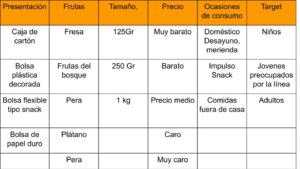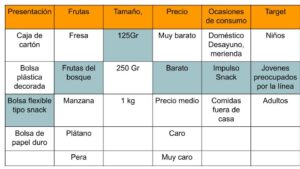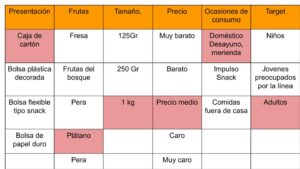THE MORPHOLOGICAL MATRIX
Accelerate your business with these expert tips on "The morphological matrix". Analyse and discover this TIP!
In this TIP we are going to talk about a complementary tool to Design Thinking, which will help you to reach a definitive conception of the product or service. We want you to practice with the morphological matrix. All entrepreneurship involves a process of satisfying needs and generating value through a product or service. Therefore, the future of your company depends on the level of acceptance that your product and/or service obtains in the market.
It is essential that the entrepreneur pays special attention to the whole process of launching the product on the market, from the initial idea to the final customer. The entrepreneur should make use of tools that help him/her throughout the whole process. On this TIP We have talked about design thinking as a creative resource for finding solutions to certain problems or needs.
What is the morphological matrix and what is it for?
It is an analytical method created by the astrophysicist Fritz Zwiky in the mid-1940s. It is a combinatorial technique of creative ideation consisting of breaking down a concept or problem into its essential elements or basic structures.
It has many uses:
- New products or services or modifications to existing ones.
- Applications for new materials.
- New market segments.
- New ways to develop a competitive advantage.
- New promotional techniques for products and services.
- Identification of opportunities for the location of new business units.
Steps for the elaboration of the morphological matrix:
THE METHODOLOGY TO BE FOLLOWED IS VERY SIMPLE AND FOLLOWS A SERIES OF INTERRELATED STEPS:
PROBLEM DEFINITION
The problem we want to work on must be very clearly defined in order to break it down into its basic elements. We are in an analytical phase where we have to be right, so we have to understand the problem in its full dimension but we have to be able to define it in very few words. As an example, imagine that we are working on the development of a new cereal based on oats with fruits.
IDENTIFICATION AND CHARACTERISATION OF PARAMETERS
The parameters or attributes. We have to detect those that are fundamental to the structure of the problem. In our example, the parameters of the morphological matrix would be: presentation, consumption occasions, consistency, taste, nutritional values, size, price, target market.
CONSTRUCTION OF A MATRIX (MORPHOLOGICAL BOX WHOSE COMBINATIONS INCLUDE THE SOLUTIONS)
Once the parameters have been established, we will have to identify the variations corresponding to each one. In the parameter presentation we can consider the different types of packaging: cardboard box, plastic bag, flexible snack bag, hard paper packaging.
The flavour parameter includes strawberry, apple, orange, grape, pear, banana and berries. It is obvious that the more alternatives we consider for each parameter, the more complex the matrix will be. In our example, the resulting matrix would be as follows:
Problem: Launch of a new cereal.

COMBINE POSSIBILITIES
This is the moment to make all possible combinations, taking into account all the variations of the morphological matrix.
Example: Oat cereal in a snack bag, 125 gm, with berries, at a cheap price for young people, for impulse consumption. We make random combinations of each parameter and then select the ones we consider most viable.
EXAMPLE COMBINATION 1

EXAMPLE COMBINATION 2

EVALUATION AND ANALYSIS OF THE BEST POSSIBILITIES
We then proceed to assess the possibilities that we consider most feasible from a technical, cost and market point of view. At this point we will have put on the table a series of ideas that will lead us to launch new products, make modifications to existing products, expand the range, or serve new market segments.
The morphological matrix is a a creative thinking and problem-solving tool that helps to generate ideas and explore solutions by combining different elements. It consists of a matrix that combines different options for each variable and allows all possible combinations to be explored.
TO CONSTRUCT A MORPHOLOGICAL MATRIX, THE FOLLOWING STEPS MUST BE FOLLOWED:
- Identify the problem or situation to be solved.
- Define the variables relevant to the problem.
- Identify all possible options for each variable and list them in a column.
- Create a matrix with all possible combinations of options.
- Evaluate each combination and select those that are most promising or feasible.
- Develop solutions or ideas from the selected combinations.
The morphological matrix is a very useful tool for the innovation and design of products or services, as well as for the resolution of complex problems. It allows all possible solutions to be explored and evaluated objectively in order to select the best option.
An example of the application of the morphological matrix could be the design of a new product. In this case, the relevant variables could be material, shape, colour, size, functions, among others. For each variable, different options could be identified, such as different types of materials, shapes or colours. By combining all the options, different designs could be generated to evaluate and select the one that is most feasible and attractive to the market.
How can an entrepreneur apply the morphological matrix?
An entrepreneur can apply the morphological matrix in the process of ideation and design of products or services.
THE FOLLOWING ARE THE STEPS TO APPLY THE MORPHOLOGICAL MATRIX IN THE CREATION OF A PRODUCT OR SERVICE:
- Define the problem or need to be solved: The entrepreneur must clearly define the problem or need that his or her product or service will address.
- Identify related variables and characteristics: The entrepreneur must identify the relevant variables and characteristics of the problem or need that his product or service will address.
- Create a morphological matrix table: The entrepreneur should create a table with the different variables and characteristics identified in the previous stage, organised in different columns.
- Generate possible combinations: The entrepreneur must generate all possible combinations of the different variables and characteristics identified in the table, organising them in different rows.
- Evaluate combinations: The entrepreneur must evaluate each of the combinations generated, considering their viability, feasibility, impact and potential benefit.
- Select the best combination: The entrepreneur must select the combination that best solves the problem or need defined in step 1 and that is most viable and feasible for his company.
- Design the product or service: Once the best combination has been selected, the entrepreneur can design his product or service, taking into account the variables and characteristics selected in the morphological matrix.
The morphological matrix can be a very useful tool for entrepreneurs, as it allows them to explore different combinations of variables and characteristics of a problem or need, which can lead to innovative and effective solutions.
Practical examples of the application of the morphological matrix
HERE ARE SOME EXAMPLES OF THE APPLICATION OF THE MORPHOLOGICAL MATRIX IN DIFFERENT AREAS:
- Product design: A company wants to launch a new product on the market and uses the morphological matrix to generate ideas. To do this, it defines different aspects of the product, such as shape, size, colour, materials, etc. It then combines the different possible options for each aspect and generates a large number of combinations that could make up the new product.
- Location selection: A company wants to open a new branch in a city and uses the morphological matrix to evaluate different location options. To do so, it defines different important criteria such as cost of rent, proximity to public transport, amount of pedestrian traffic, etc. It then combines different options for each criterion and evaluates each resulting combination to find the best location.
- Strategic planning: A company wants to expand into new markets and uses the morphological matrix to generate strategic options. To do this, it defines different aspects of the expansion, such as geography, market segment, business model, etc. It then combines different options for each aspect and evaluates each resulting combination to determine the optimal strategy.
- Development of services: A company wants to offer a new service to its customers and uses the morphological matrix to generate ideas. To do this, it defines different aspects of the service, such as characteristics, price, delivery mode, etc. It then combines different options for each aspect and generates a large number of combinations that could make up the new service.
In general, the morphological matrix can be applied in any situation where ideas need to be generated or different options need to be evaluated. It is a very useful tool to foster creativity and innovation in the decision-making process.
How to use the morphological matrix in the internationalisation of a company?
The morphological matrix can be a useful tool for the internationalisation of a company.
THE FOLLOWING ARE SOME STEPS THAT CAN HELP TO USE THIS TOOL IN THIS CONTEXT:
- Identify the key factors: First, it is important to identify the key factors that may influence the success of the company's internationalisation. These can include factors such as the culture of the destination country, trade barriers, transport and logistics costs, trade regulations, etc.
- Create a list of options: Once the key factors have been identified, a list of options can be created for each of them. For example, if one of the key factors is the culture of the destination country, you can list options such as adapting products to local preferences, hiring local staff, establishing strategic alliances with local companies, etc.
- Combine the options: After having created the list of options, the morphological matrix can be used to combine them to generate new ideas. For example, you can combine the option to adapt products to local preferences with the option to establish strategic alliances with local companies to create a new idea of establishing a joint venture with a local company to adapt products to local preferences.
- Assess the options: Once new ideas have been generated, it is important to evaluate them to determine their feasibility and potential positive impact on the internationalisation of the company. Different evaluation criteria can be used, such as revenue potential, cost of implementation, return on investment time, alignment with the company's strategy, etc.
- Selecting the best options: After having evaluated all options, you can select the best ones to implement in your company's internationalisation strategy. It is important to keep in mind that some options may be riskier than others and that you should be prepared to face possible challenges and risks.
In summary, the morphological matrix can be a useful tool for the internationalisation of a company by helping to identify different options, combine and evaluate them in order to select the best ones to implement in the company's strategy.
APPLY THIS TIP TO YOUR PROJECT
TASK
Now that you have learned all about this TIP, you should be able to answer these questions:
- What parameters would make up the morphological matrix of your project? What alternatives would you consider for each variable? Elaborate the structure and upload it to the platform.
- Do you think this morphological matrix method can be useful in your project?
- What aspect of your project do you think you could use it for?
- If you were thinking of launching a coworking centre, which attributes would you consider essential in the creation of the matrix?
CASE STUDY
Juan is an entrepreneur who is developing a mobile application for language teaching. The app already has a solid foundation, but Juan wants to add new features to differentiate it from the competition and improve the user experience. To do this, he decides to use the morphological matrix to generate ideas and analyse them systematically. First, he defines the key areas he wants to improve in his application: gamification, social interaction and personalisation of learning.
Then start listing the different options you have for each area. For gamification, for example, consider including word games, vocabulary quizzes or competitions between users. For social interaction, think about options such as study groups, chat between users or even online classes with teachers. And for personalisation of learning, consider options such as user level assessment, personalised recommendations or customised study plans.
John then begins to combine different options to form new ideas. For example, he might combine the word game with user-to-user chat to create a kind of real-time guessing game. Or he could combine user level assessment with personalised recommendations to offer tailor-made lesson plans based on the user's level and interests.
Finally, Juan analyses each option critically, assessing its viability, its profitability and its impact on the user experience. In this way, he is able to select the best ideas and focus his efforts on those that offer the greatest potential for success.
With the help of the morphology matrix, Juan has been able to systematically generate new ideas for implementation and critically analyse them to select the most promising ones. In addition, he has been able to focus his efforts on key areas to improve the user experience and differentiate himself from the competition.
QUIZ
- 💻 PRACTICE with an expert in the next practical webinar.
- 🔎 CONSULT more related TIPs with this same theme.
- 📖 AMPLIA your knowledge by downloading this EBOOK y this EBOOK.
THINK ABOUT YOU
- 🚀 IMPULSA your company in the next acceleration programme, ¡book your place now!
- 🥁 PRACTICE with your project in this practical webinar, ¡apply for your place!
- 🌐 CONTACT with other entrepreneurs and companies, ¡register and take part in the next Networking!
THINK ABOUT HELPING OTHERS
- 🤝COLLABORATE as a volunteer: expert, mentor, inverter, awarding, Spreading the word, challenging, innovating, creating a TIP...
- 💬 RECOMMENDS this programme to reach out to more entrepreneurs by Google.
- 👉 SHARE your learning!
- 📲 SEND this TIP 👇









